德国简介(英文)解剖
- 格式:ppt
- 大小:12.81 MB
- 文档页数:61
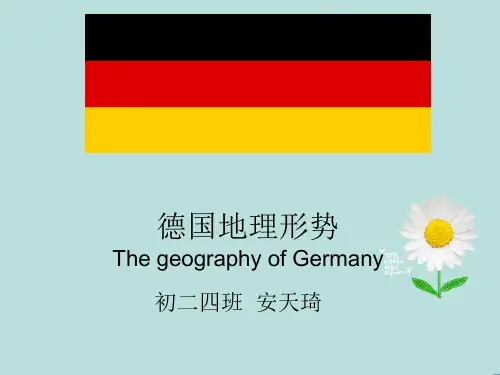
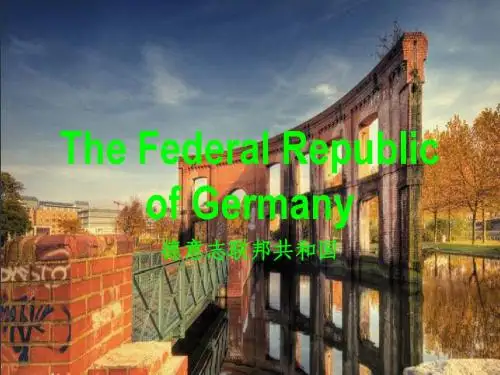

德国基础解剖学入门41. Das Herz (The Heart)- Location: in the thorax, between the lungs- Function: pumps blood throughout the body- Structure: four chambers (right and left atria, right and left ventricles), heart valves, coronary arteries and veins, cardiac muscle fibers2. Die Lungen (The Lungs)- Location: in the thorax, on either side of the heart- Function: exchange oxygen and carbon dioxide between the body and the environment- Structure: bronchi, bronchioles, alveoli, pleural membranes, diaphragm3. Das Gehirn (The Brain)- Location: in the skull, above the spinal cord- Function: control center for the body, responsible for sensory perception, movement, cognition, and emotions- Structure: cerebrum, cerebellum, brainstem, meninges, blood vessels4. Das Verdauungssystem (The Digestive System)- Location: starts in the mouth, ends at the anus- Function: processes food and extracts nutrients for the body- Structure: mouth, throat, esophagus, stomach, small and large intestines, liver, pancreas, gallbladder5. Das Skelett (The Skeleton)- Location: throughout the body- Function: supports the body, protects organs, allows for movement- Structure: bones, cartilage, ligaments, tendons6. Die Muskeln (The Muscles)- Location: throughout the body- Function: generate movement, maintain posture, generate heat- Structure: muscle fibers, tendons, fascia, neuromuscular junctions7. Das Nervensystem (The Nervous System)- Location: throughout the body- Function: controls and coordinates body functions, responds to stimuli, processes information- Structure: neurons, glial cells, spinal cord, brain, peripheral nerves, sensory receptors。


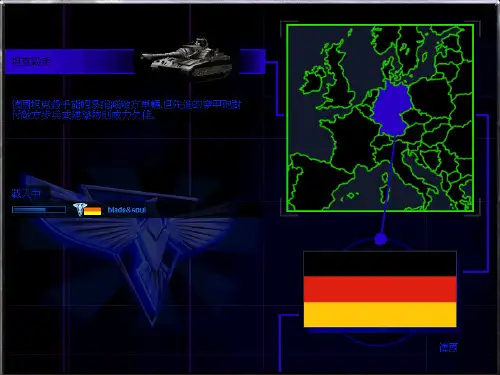
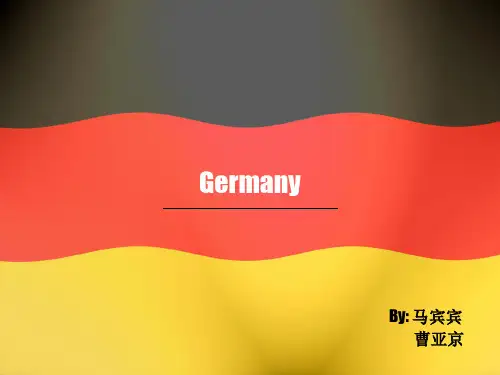
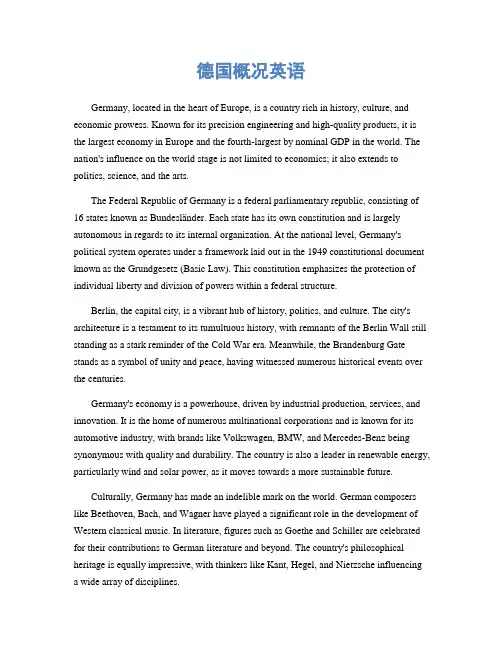
德国概况英语Germany, located in the heart of Europe, is a country rich in history, culture, and economic prowess. Known for its precision engineering and high-quality products, it is the largest economy in Europe and the fourth-largest by nominal GDP in the world. The nation's influence on the world stage is not limited to economics; it also extends to politics, science, and the arts.The Federal Republic of Germany is a federal parliamentary republic, consisting of 16 states known as Bundesländer. Each state has its own constitution and is largely autonomous in regards to its internal organization. At the national level, Germany's political system operates under a framework laid out in the 1949 constitutional document known as the Grundgesetz (Basic Law). This constitution emphasizes the protection of individual liberty and division of powers within a federal structure.Berlin, the capital city, is a vibrant hub of history, politics, and culture. The city's architecture is a testament to its tumultuous history, with remnants of the Berlin Wall still standing as a stark reminder of the Cold War era. Meanwhile, the Brandenburg Gate stands as a symbol of unity and peace, having witnessed numerous historical events over the centuries.Germany's economy is a powerhouse, driven by industrial production, services, and innovation. It is the home of numerous multinational corporations and is known for its automotive industry, with brands like Volkswagen, BMW, and Mercedes-Benz being synonymous with quality and durability. The country is also a leader in renewable energy, particularly wind and solar power, as it moves towards a more sustainable future.Culturally, Germany has made an indelible mark on the world. German composers like Beethoven, Bach, and Wagner have played a significant role in the development of Western classical music. In literature, figures such as Goethe and Schiller are celebrated for their contributions to German literature and beyond. The country's philosophical heritage is equally impressive, with thinkers like Kant, Hegel, and Nietzsche influencing a wide array of disciplines.The German education system is renowned for its emphasis on quality and accessibility. The country offers a range of educational opportunities, from vocational training to high-level research at its world-class universities. Moreover, the absence of tuition fees at public universities in Germany removes a significant barrier to higher education.In terms of geography, Germany boasts a diverse landscape that ranges from the windswept North Sea coastlines to the rugged peaks of the Bavarian Alps. The Rhine River, one of Europe's longest rivers, flows through the wine-growing regions of the west, while the Black Forest in the southwest is a haven for hikers and nature lovers.German cuisine, often characterized by its heartiness and regional diversity, includes staples such as bread, sausages, and beer. Each region has its own specialties, with dishes like Bavarian pretzels, Thuringian bratwurst, and Black Forest cake being well-known examples.In conclusion, Germany stands as a testament to resilience and progress. From the ashes of war, it has risen to become a beacon of stability, innovation, and cultural richness. Its commitment to democracy, environmental sustainability, and social welfare continues to set an example for nations around the world. As Germany looks to the future, it carries with it the lessons of its past, striving for a society that values both tradition and progress. 。
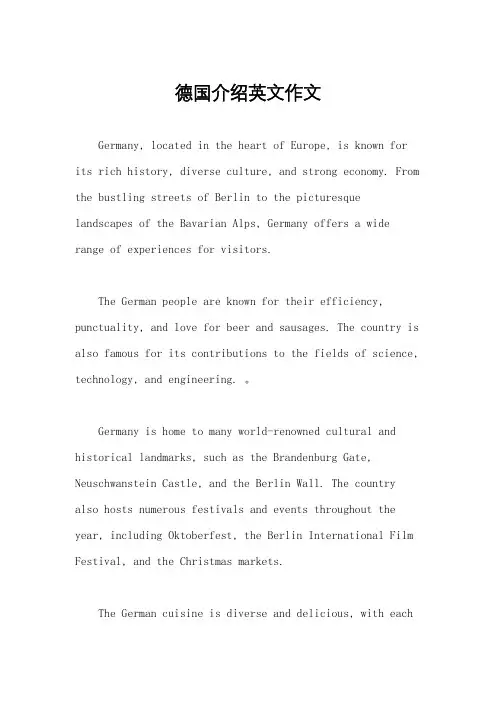
德国介绍英文作文Germany, located in the heart of Europe, is known for its rich history, diverse culture, and strong economy. From the bustling streets of Berlin to the picturesque landscapes of the Bavarian Alps, Germany offers a wide range of experiences for visitors.The German people are known for their efficiency, punctuality, and love for beer and sausages. The country is also famous for its contributions to the fields of science, technology, and engineering. 。
Germany is home to many world-renowned cultural and historical landmarks, such as the Brandenburg Gate, Neuschwanstein Castle, and the Berlin Wall. The country also hosts numerous festivals and events throughout the year, including Oktoberfest, the Berlin International Film Festival, and the Christmas markets.The German cuisine is diverse and delicious, with eachregion offering its own specialties. From the hearty dishes of Bavaria to the seafood of the North Sea, there is something for every palate in Germany. 。
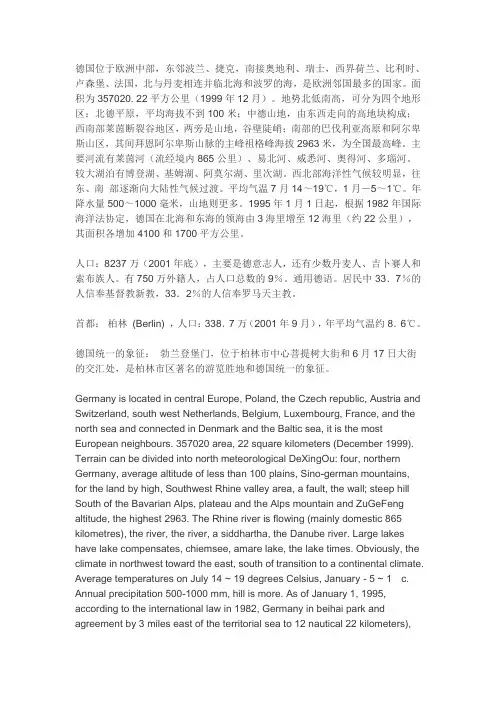
德国位于欧洲中部,东邻波兰、捷克,南接奥地利、瑞士,西界荷兰、比利时、卢森堡、法国,北与丹麦相连并临北海和波罗的海,是欧洲邻国最多的国家。
面积为357020. 22平方公里(1999年12月)。
地势北低南高,可分为四个地形区:北德平原,平均海拔不到100米;中德山地,由东西走向的高地块构成;西南部莱茵断裂谷地区,两旁是山地,谷壁陡峭;南部的巴伐利亚高原和阿尔卑斯山区,其间拜恩阿尔卑斯山脉的主峰祖格峰海拔2963米,为全国最高峰。
主要河流有莱茵河(流经境内865公里)、易北河、威悉河、奥得河、多瑙河。
较大湖泊有博登湖、基姆湖、阿莫尔湖、里次湖。
西北部海洋性气候较明显,往东、南部逐渐向大陆性气候过渡。
平均气温7月14~19℃,1月-5~1℃。
年降水量500~1000毫米,山地则更多。
1995年1月1日起,根据1982年国际海洋法协定,德国在北海和东海的领海由3海里增至12海里(约22公里),其面积各增加4100和1700平方公里。
人口:8237万(2001年底),主要是德意志人,还有少数丹麦人、吉卜赛人和索布族人。
有750万外籍人,占人口总数的9%。
通用德语。
居民中33.7%的人信奉基督教新教,33.2%的人信奉罗马天主教。
首都:柏林(Berlin) ,人口:338.7万(2001年9月),年平均气温约8.6℃。
德国统一的象征:勃兰登堡门,位于柏林市中心菩提树大街和6月17日大街的交汇处,是柏林市区著名的游览胜地和德国统一的象征。
Germany is located in central Europe, Poland, the Czech republic, Austria and Switzerland, south west Netherlands, Belgium, Luxembourg, France, and the north sea and connected in Denmark and the Baltic sea, it is the most European neighbours. 357020 area, 22 square kilometers (December 1999). Terrain can be divided into north meteorological DeXingOu: four, northern Germany, average altitude of less than 100 plains, Sino-german mountains, for the land by high, Southwest Rhine valley area, a fault, the wall; steep hill South of the Bavarian Alps, plateau and the Alps mountain and ZuGeFeng altitude, the highest 2963. The Rhine river is flowing (mainly domestic 865 kilometres), the river, the river, a siddhartha, the Danube river. Large lakes have lake compensates, chiemsee, amare lake, the lake times. Obviously, the climate in northwest toward the east, south of transition to a continental climate. Average temperatures on July 14 ~ 19 degrees Celsius, January - 5 ~ 1 ° c. Annual precipitation 500-1000 mm, hill is more. As of January 1, 1995, according to the international law in 1982, Germany in beihai park and agreement by 3 miles east of the territorial sea to 12 nautical 22 kilometers),the area of each increase 4100 and 1,700 square kilometers.Population: 8237 million (2001), mainly is the German people, and a few danes, carefree gypsy and cable cloth. Foreigners have 7.5 million, total population of 9%. German. People who believe in 33.7% protestant and Roman Catholic 33.2% people believe.Capital: Berlin (Berlin), population: 338.7 million (September 2001), average temperature, about 6 degrees Celsius.German reunification, the symbol of the Brandenburg gate in Berlin: downtown lindens street and June 17th street, is the famous tourist attractions in Berlin, Germany and the symbol of unity.In Germany, it is impolite to cross your arm over people who are shaking hands, as well as chew gum in public. Talking while your hands are in your pockets is also impolite. In general, Germans greet people with handshakes. German men wait for women to extend their hands before shaking hands with them, as well as shaking hands with women first when other men are present. Normally, Germans do not greet strangers on the streets. Titles along with the last names are used when being introduced to a stranger.Germans do not cross the street ignoring the lightDo not cross the street when the light is red, NO MATTER WHAT! Germans always wait for the light to turn green whether there is a car in sight or not. If you attempt to cross, you will probably be chided by at least one of the people in the queue and you will hear a general tsssk.Germans are very direct and they are always rightMost Germans have no problem telling you how they feel about something, even if you are a complete stranger. Don’t try to argue with a German, it is a complete waste of time. Just remember they are always right, nod your head and don’t waste your breath.。
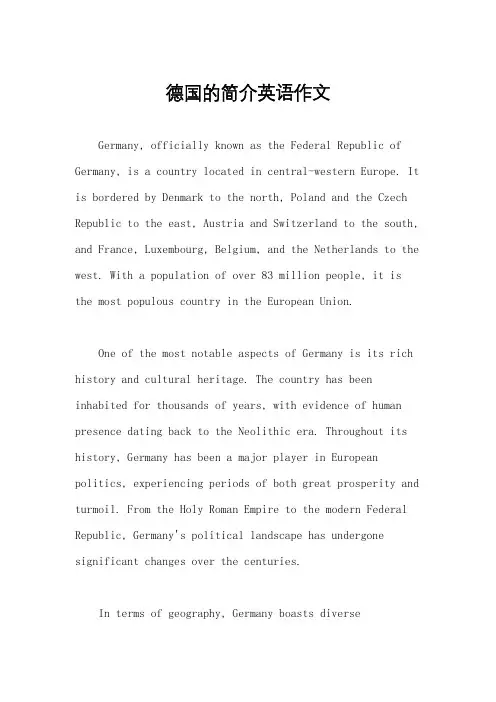
德国的简介英语作文Germany, officially known as the Federal Republic of Germany, is a country located in central-western Europe. It is bordered by Denmark to the north, Poland and the Czech Republic to the east, Austria and Switzerland to the south, and France, Luxembourg, Belgium, and the Netherlands to the west. With a population of over 83 million people, it is the most populous country in the European Union.One of the most notable aspects of Germany is its rich history and cultural heritage. The country has been inhabited for thousands of years, with evidence of human presence dating back to the Neolithic era. Throughout its history, Germany has been a major player in European politics, experiencing periods of both great prosperity and turmoil. From the Holy Roman Empire to the modern Federal Republic, Germany's political landscape has undergone significant changes over the centuries.In terms of geography, Germany boasts diverselandscapes ranging from the majestic Alps in the south to the picturesque forests and rivers of the central and northern regions. The country is also home to several major rivers, including the Rhine, Danube, and Elbe, which have played crucial roles in shaping its history and economy.Germany is renowned for its contributions to various fields such as science, technology, philosophy, literature, music, and art. Throughout history, German thinkers and innovators have made significant advancements that have had a profound impact on the world. Figures like Albert Einstein, Ludwig van Beethoven, Johann Wolfgang von Goethe, and Karl Marx are just a few examples of the manyinfluential Germans who have left their mark on human history.Economically, Germany is one of the world's leading industrialized nations and is known for its strong export-oriented economy. It is home to several multinational corporations and is a global hub for innovation and technology. The country's automotive industry, in particular, is world-renowned, with brands like Volkswagen,BMW, and Mercedes-Benz being household names across the globe.Germany is also known for its high standard of living, excellent healthcare system, and well-developed infrastructure. Its education system is highly regarded internationally, with a strong emphasis on academic excellence and vocational training.Culturally, Germany is a diverse and vibrant country with a rich tapestry of traditions, customs, and regional dialects. It is famous for its beer culture, Oktoberfest celebrations, and traditional folk music and dance. Additionally, Germany is home to numerous UNESCO World Heritage Sites, including the Cologne Cathedral, the Berlin Museumsinsel, and the Classical Weimar.In recent years, Germany has emerged as a key player in European and global affairs, playing a leading role in the European Union and the international community. It is known for its commitment to democracy, human rights, and environmental sustainability.In conclusion, Germany is a fascinating country with a rich history, vibrant culture, and strong economy. From its scenic landscapes to its world-class innovation, Germany continues to captivate the world with its dynamism and charm.。
德国简介作文英文英文回答:I'm delighted to introduce you to the fascinating country of Germany, a land steeped in history, culture, and innovation. From its picturesque landscapes to its vibrant cities, Germany offers a captivating blend of tradition and modernity.Situated in the heart of Europe, Germany boasts diverse topography, ranging from the snow-capped Bavarian Alps in the south to the sandy beaches of the North Sea coast. Its enchanting forests, shimmering lakes, and rolling hills provide a breathtaking backdrop for nature enthusiasts.Germany's history is a tapestry woven with both triumphs and tragedies. From the grandeur of the Holy Roman Empire to the horrors of the Holocaust, the country has witnessed pivotal events that have shaped its destiny. Today, Germany stands as a symbol of resilience,reconciliation, and democratic values.The German people are renowned for their industriousness, precision, and love for the arts. They have made significant contributions to science, philosophy, literature, and music. From the groundbreaking theories of Albert Einstein to the melodious compositions of Johann Sebastian Bach, Germany has produced intellectual giants who have left an indelible mark on the world stage.Berlin, the captivating capital, is a melting pot of culture and history. Its iconic landmarks, such as the Brandenburg Gate and the Reichstag Building, bear witness to the city's tumultuous past. The thriving art scene, world-class museums, and vibrant nightlife make Berlin a cultural paradise.Other major cities like Munich, Hamburg, and Cologne also boast unique charms. Munich, known as the "Beer Capital of Germany," hosts the legendary Oktoberfest festival. Hamburg, a bustling port city, offers a blend of maritime history and contemporary architecture. Cologne ishome to the majestic Cologne Cathedral, a testament to the country's architectural prowess.Germany's economic strength is a testament to its innovative spirit. The country has a highly developed infrastructure, cutting-edge industries, and a skilled workforce. It is a global leader in automotive engineering, pharmaceuticals, and renewable energy.In addition to its economic achievements, Germany places great importance on social welfare. Its universal healthcare system, affordable education, and generoussocial benefits create a high quality of life for its citizens. The country is also committed to environmental protection, with a strong focus on sustainability and renewable energy sources.中文回答:很高兴向大家介绍这个迷人的国家——德国,这是一个历史悠久、文化丰富、创新十足的国度。